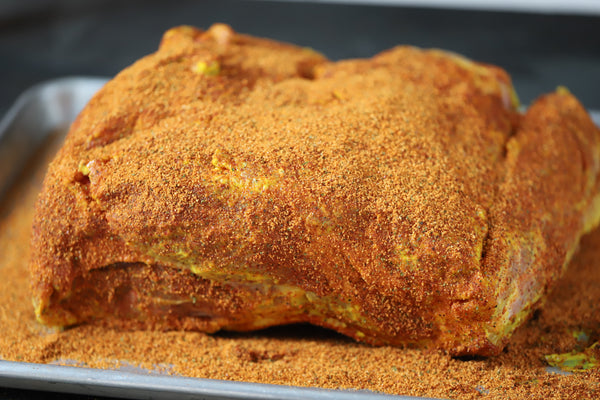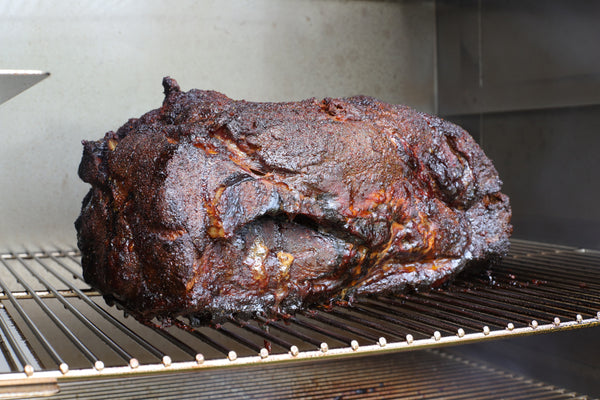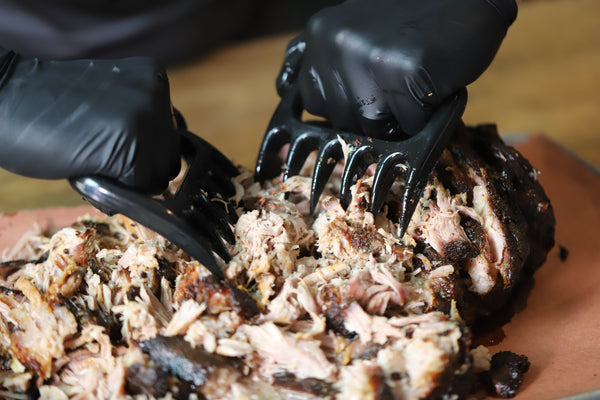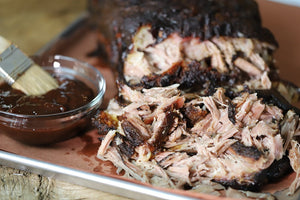How To: Classic Smoked Pork Shoulder
This classic smoked pork shoulder is cooked low ‘n slow for melt-in-your-mouth tenderness and the perfect amount of wood-fired flavor.
This pulled pork recipe isn’t made for crockpots, pressure cookers or ovens, this is the real deal. With a crisp flavorful bark on the outside and decadent, fork-tender meat on the inside, nothing quite beats the payoff of a 16-hour smoke. Yes, it’s an all-day project, but one of the easiest you could undertake. Just don’t call us when your neighbors break down your back gate trying to steal a bite.
You'll Need:
- Smoker (we used the Pro Smoker PK100): Go Pro or go home. This commercial-quality smokehouse will provide you professional results every time.
- Temperature Probe: No matter what kind of smoker you use, it’s important that you have a way to gauge temperature accurately.
- Meat Claws: You can get primal and tear the meat apart with your hands, but our test team found it much easier to use these bear-like claws.
- 4 lb. Pork Shoulder (bone-in):
- 1/2-1 Cup Mustard (Any variety works)
- BBQ Rub: Go for something sweet and smoky here like our Notorious P.I.G. Pulled Pork Rub
1. Pork Butt or Pork Shoulder?
Despite the names, both cuts of meat come from the shoulder of the pig, with pork butt (also called Boston butt) higher on the foreleg and shoulder (aka picnic shoulder) just beneath it. Both are fatty and filled with tough connective tissues that will render and melt into silky goodness during a long, slow cooking process. Either cut works for making delicious pulled pork, so choose whichever you can find at the highest quality. If you’re smoking for a crowd, plan on a 25-30% reduction in size after the cook is complete.

2. Slather
Getting your roast ready for the cook is simple. Slather on a nice layer of mustard (we used yellow, but you can use any variety you like), and spread evenly over the entire shoulder. This adds flavor, helps retain moisture, and acts as an adhesive for your BBQ rub.

3. Dust
After you’ve applied your mustard “glue,” dust your pork in a generous coating of a high-quality BBQ rub. The classic flavor for smoked pork is sweet, salty and smoky so go with a classic like our Notorious P.I.G. or Rodeo Rub. As your pork cooks and the fat renders, this layer will concentrate and create a caramelized crust known as “the bark.”

4. Smoke
Preheat your smoker to 225°F, this is the standard and safest temp for smoking your shoulder. Any higher, and you can risk stringy dry pork and tough connective tissue that doesn't break down properly. In general, the cooking time for a 4-pound pork shoulder smoking at 225° degrees is around 90 minutes per pound, but this can vary greatly depending on what type of smoker you’re using. We let our smoke overnight in the PK100 and after about 16 hours, it was fall off the bone perfection.
Once it’s up to temp, just place your pork right on the rack and go relax, your work here is done.

5. How to Know When It’s Done
Your pork shoulder is done when the internal temperature is around 195°F and the crust has a deep black, almost burnt-looking bark. The internal probe should also be inserted with little to no resistance from all angles.
If you’ve been watching your pork like a hawk and noticed a plateau at the 160-170° mark, you're not crazy. Known to pitmasters as "the stall," this lag in temperature can last for several hours while the moisture moves to the surface and evaporates. Patience is a virtue here, so avoid cranking up the heat or wrapping your shoulder in aluminum foil, as this can cause soggy bark and that’s just not worth it.

6. Pull the Pork
Remove your pork from the smoker and let rest for about 20-30 minutes. Using the bear claws (or your man claws), shred the pork into strands including the fat chunks and crispy bits of bark.
The whole “good things come to those who wait” has never been truer. Eat straight from the pan or top with a great BBQ sauce for an extra punch.




1 comment
I just ate, and now I want to smoke a pork shoulder. Well done!